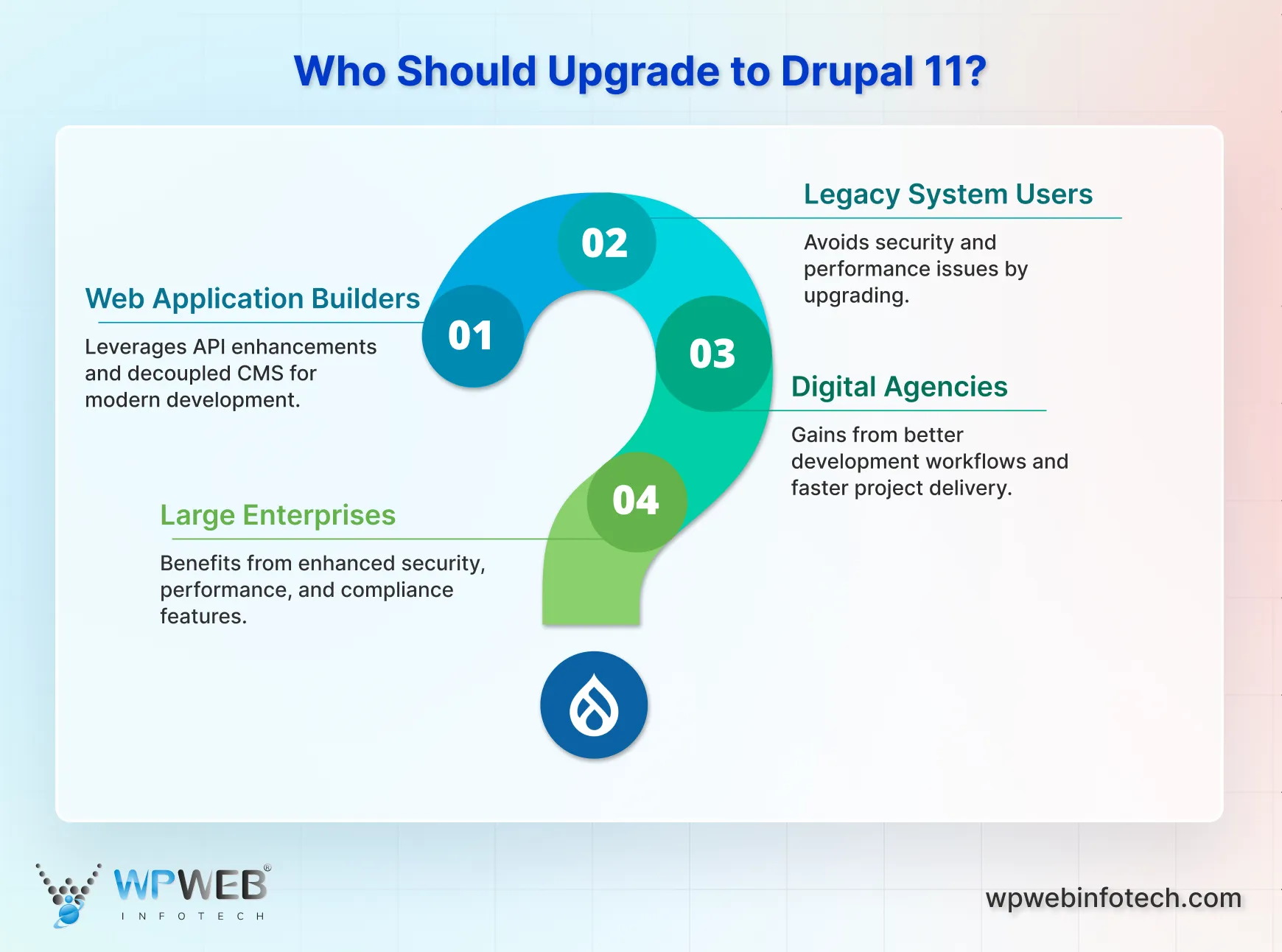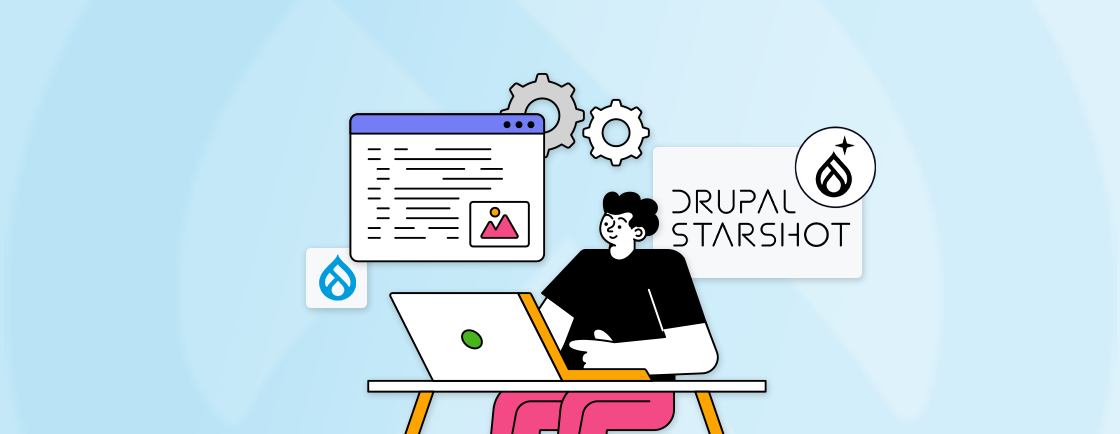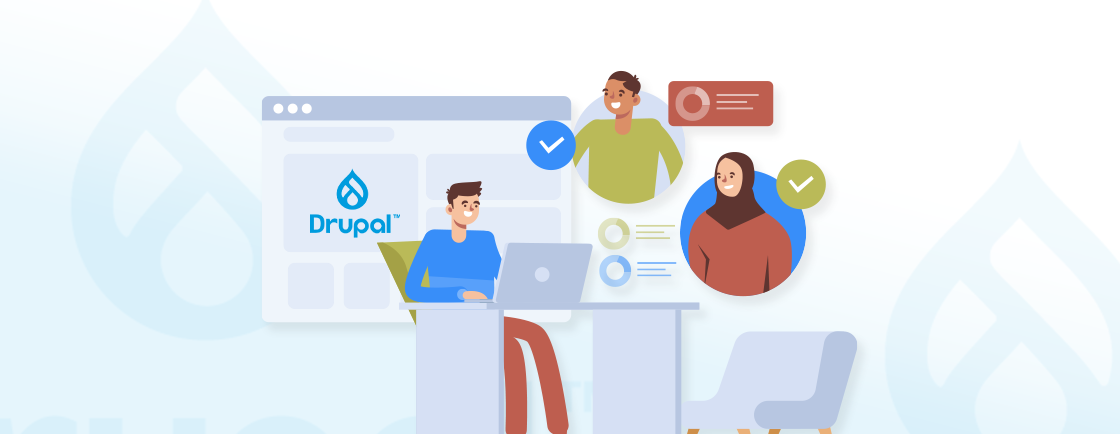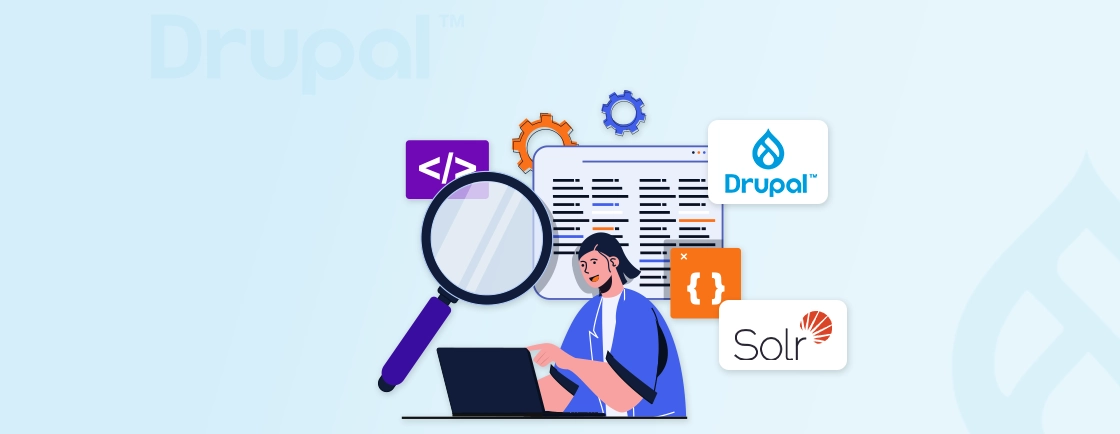Quick Summary
Drupal 11, released in August 2024, comes with a redesigned admin interface, the stable “Recipes” feature, and improved content modeling. With easier field management, better performance, and greater security, Drupal 11 is damn good. Upgrading from Drupal 10 to 11, more changes, benefits, and updated features are mentioned in this article.
Table of Contents
Drupal 11, released on August 2, 2024, marks an exceptional milestone in the evolution of content management systems. This article examines what comes in this latest 11.1.8 update and why businesses and developers worldwide are transitioning to this powerful platform. With better security, improved performance, and out-of-the-box features, Drupal 11 represents the future of web development.
What is Drupal 11?
Drupal 11 stands as the latest major release in the content management system lineage, following the path from version 7 → 8 → 9 → 10 → 11. The latest version of Drupal is a big leap forward in CMS technology. This one is designed specifically for developers, enterprises, and digital agencies looking for powerful, scalable solutions.
The current stable release is Drupal 11.1.8. It comes with months of refinements and bug fixes since the initial Drupal 11 launch. This version of Drupal 11 builds upon the solid foundation of its predecessors, introducing new, updated, and AI-driven features that simplify development workflows and completely change user experiences.
What is New in the Drupal 11.1.8 Version?
Businesses today need CMS solutions that can handle complicated requirements, high-volume traffic, and diversified content. The modular architecture, all-inclusive API, and powerful security framework of Drupal 11 meet these needs. The platform targets 3 primary audiences:
1. Technical developers who need flexible customization options
2. Enterprise organizations requiring scalable solutions, and
3. Digital agencies that are managing multiple client projects.
Understanding what makes Drupal 11.1.8 special requires examining the Drupal 11 changes that make it different from previous versions. These modifications are the work of years of community feedback and development expertise. But the core goal of the organization is to make Drupal 11 the most refined CMS available today.
Why Upgrade to Drupal 11?
1. Better Security Architecture
Drupal 11 is required for any commercial websites that handle private data due to its improved security. The platform improves login security, access management, and automatic vulnerability fixes. These features keep websites safe from emerging online dangers and compliant with GDPR, CCPA, and HIPAA.
The Drupal 11 security architecture also mitigates existing vulnerabilities in multiple ways. Its increased security will appeal to companies deciding between Drupal 10 and 11 for security-sensitive apps. These security upgrades make Drupal 11 the greatest solution for financial institutions, healthcare organizations, and government agencies.
2. Superior Performance and Scalability
Drupal 11 is 50% faster than earlier versions, especially with PHP 8.3. This performance boost boosts SEO, conversion rates, and user experience, too. The efficient caching, database queries, and coding help websites to handle traffic spikes without slowing down even a bit.
Apart from that, performance improvements are Drupal 11’s fundamental changes that benefit all websites. Drupal 11 outperforms Drupal 10 in scalability. These updates improve memory management, database queries, and browser caching.
3. A Whole New Development Experience
The updated codebase supports PHP 8.3, Symfony 7, and API enhancements. Better debugging tools, documentation, and workflows save developers time and increase code quality. The improved developer experience speeds project delivery and lowers maintenance expenses as well.
One of the most impactful Drupal 11 Features for developers is Single Directory Components (SDC), moving from experimental to stable in core. All template, style, script, and configuration files are in the same directory in SDC, which simplifies front-end development and makes components more shareable.
Development teams like Drupal 11’s detailed documentation and enhanced error handling. These changelogs simplify difficult changes while retaining code quality.
4. Future-Proof Architecture
The Drupal 11 investment prepares for future web technologies and standards. The 11.1.8 Drupal’s architecture provides compatibility with new technologies and existing customizations.
5. Improved Content Authoring Experience
Drupal 11’s improved CKEditor 5 integration offers autoformat capability that automatically formats lists and headers. Markdown shortcuts speed up content generation, and media management simplifies editorial workflows. Apart from this, it also excels in:
- Automatic formatting, mentions, and Word pasting capabilities help content editors create content faster and with less training.
- Modern WYSIWYG editing interfaces resemble Google Docs, Medium, and other platforms.
- Content teams can now operate across Draft, Staging, and Live environments and deploy changes with a click.
- The platform now supports WebP and AVIF, helping editors produce high-quality photos in small files.
- Custom tags help editors to segment assets for faster search and retrieval through an improved interface, optimizing asset management workflows.
Drupal 11 upgrade benefits go beyond version maintenance. Organizations that adopt this upgrade get immediate security, performance, and productivity gains while positioning themselves for digital development.
What Are The New Drupal 11 Features?
Each new feature provides major improvements over prior versions, addressing daily issues for developers, content creators, and administrators. All of these capabilities work together to produce a platform that combines technical superiority with usability, making Drupal 11 a worthwhile upgrade.
1. Single Directory Components (SDC)
SDC lets developers house all files for a UI component (Twig, JS, CSS, config) in one directory. This structure increases code reusability, easier sharing, streamlined navigation, and better collaboration between backend and frontend teams. It is also out-of-the-box in core, so no longer experimental or requiring additional configuration.
2. Performance Enhancements
- Advanced Caching: Better server-side and front-end caching decreases server load and speeds page load.
- Optimized Database Queries: Faster data retrieval and processing for busy sites.
- Handled JS/CSS Better: Reduced resources and improved rendering.
- BigPipe & LazyLoading: This increases initial rendering; lazily loading pictures improves page speed and SEO.
3. Modern Admin Navigation
The new left-aligned, collapsible vertical navigation panel is very good to look at. There is faster, more intuitive access to site sections (especially for content managers and marketers). Customizable and responsive; also introduces new announcement feeds and role-based quick filters, and easy database management.
4. Stable Workspaces for Content Staging
As mentioned before, the Workspaces module is now core, so editors can manage separate content environments (Draft, Staging, Live). Now you can also publish and review content in different spaces, making major updates, launches, and editorial QA easy for large teams.
5. Recipes API
There are now pre-configured recipes to add complete feature sets, modules, and configurations to any website. This enables rapid site-building and easier reusability of best practices.
6. Field UI Overhaul
Now there is UI for field creation, grouping, configuration, and drag-and-drop ordering. An enhanced experience is more visual (utilizing modern icons and grouping) and intuitive for editors.
7. CKEditor 5 Integration
- Auto-formatting for lists/headers and Markdown shortcut support for writers.
- WYSIWYG experience comparable to Google Docs or Notion.
- Simple media embedding, drag-and-drop functionality, and improved pasting from Word.
8. Enhanced Media Management
Media Library is more powerful, with easy tagging, searching, and image format support (e.g., WebP, AVIF). There’s also improved asset organization, lazy loading, and version control on media entities.
9. Access Policy API & Advanced Permissions
Now you can control permissions by context (not just roles), e.g., time-based access, rate limits, or 2FA. There is also a new ability to disable “superuser” accounts for better enterprise security.
10. Development & Headless CMS Updates
- Improved APIs (REST, JSON:API, GraphQL) for integrating React, Vue, or other JS frontends.
- Decoupled navigation via Linkset (frontend frameworks can get all menus and links with one call).
- Requires PHP 8.3+ for maximum speed, security, and compatibility.
- Supports the latest MySQL, MariaDB, PostgreSQL, Composer, etc. And future-proofs your website.
- Removals: Deprecated APIs and modules cleaned out, leading to a smaller, safer, faster core.
11. Better Accessibility
The Claro admin theme is set as the default, designed for WCAG accessibility (better color contrast, navigation, screen reader support). Accessibility validation tools, consistent HTML structure, and keyboard navigation.
12. Project Announcements & Taxonomy Term Revisions
Admin can see project news/updates within the Drupal 11 dashboard. Taxonomy terms now support full revision history and rollbacks.
13. Block & Layout Builder Improvements
More flexible block creation, duplication, and placement via improved UI. Layout Builder refinements: nested layouts, visual previews, reusable templates.
How to Update Drupal 10 to 11?
Step 1 – Update to Drupal 10.3+
Mandatory Requirement: Your site MUST be on Drupal 10.3.0 or later
Check the current version using:
drush status
# Update to latest Drupal 10.3.x
composer update drupal/core-recommended --with-dependencies
Step 2 – Take Website Backup
Create Complete Backup
# Database backup with Drush
drush sql-dump > backup-$(date +%Y%m%d).sql
# For full site backup with files
tar -czf site-backup-$(date +%Y%m%d).tar.gz /path/to/drupal-site
Verify that your backup can be successfully restored before proceeding or not.
Step 3 – Environment Audit
Remove Unused Components
- Clean up unused modules, themes, and content
- Remove deprecated modules from Drupal 10
- Check for custom code dependencies
Step 4 – Install and Run Upgrade Status Module
Install Upgrade Status
composer require drupal/upgrade_status
drush en upgrade_status
Do an analysis
- Go to: Admin > Reports > Upgrade Status
- Review all sections: IDE, Projects, Custom Codes
- Export HTML report (if details are required)
Step 5 – Resolve Deprecated Core Modules
Removed Core Modules in Drupal 11
- Actions UI
- Activity Tracker
- Book
- Forum
- Statistics
- Tour
Two Options:
1. Stop using deprecated modules in Drupal 10
2. Install versions before upgrading to Drupal 11
# Example:
composer require drupal/statistics
drush en statistics
Step 6 – Update Supported Modules
Update All Contributed Projects
# Check module
composer require drupal/webform:^6.2 --no-update
# Update modules to Drupal 11 compatible versions
composer update --dry-run
composer update
Step 7 – Custom Code Migration
Use Drupal Rector for Automated Fixes
composer require --dev palantirnet/drupal-rector
vendor/bin/rector process web/modules/custom --dry-run
vendor/bin/rector process web/modules/custom
Step 8 – Create Staging Environment
For this, you need to:
1. Clone the entire website to the staging/development environment
2. Test full functionality before moving forward
3. Verify that all custom features are working as per requirements
Step 9 – Execute the Upgrade
Set Proper File Permissions
chmod 777 web/sites/default
chmod 666 web/sites/default/*settings.php
chmod 666 web/sites/default/*services.yml
Update Core with Composer
# Update core packages
composer require 'drupal/core-recommended:^11' \
'drupal/core-composer-scaffold:^11' \
'drupal/core-project-message:^11' --no-update
# Update Drush
composer require 'drush/drush:^13' --no-update
# Remove separate drupal/core (if present)
composer remove drupal/core --no-update
# Test update
composer update --dry-run
# Execute actual update
composer update
Step 10 – Run Database Updates
Go with Database Updates
# Put site in maintenance mode
drush state:set system.maintenance_mode 1
drush cr
# Run database updates
drush updb -y
# Clear caches
drush cr -y
# Export configuration changes
drush cex -y
Restore File Permissions
chmod 755 web/sites/default
chmod 644 web/sites/default/*settings.php
chmod 644 web/sites/default/*services.yml
Step 11 – Testing Phase
For Testing
# Run a status check
drush status
# Check for errors
drush watchdog:tail
# Run cron
drush cron
# Verify configuration
drush config:status
Step 12 – Performance and Security Audit
Run PHPCS for Code Standards
# If using PHPCS
phpcs web/modules/custom web/themes/custom
That’s it! Now your website is successfully migrated from Drupal 10 to 11.
Who Should Consider Upgrading to Drupal 11?

1. Large Enterprise and Organizations
Drupal 11’s increased security, performance, and compliance features benefit enterprises and scale websites. Financial companies, healthcare organizations, and government bodies benefit from the platform’s security and high-traffic handling.
Enterprise decision-makers choosing Drupal 10 or 11 should evaluate long-term support and feature roadmaps. Drupal 11’s extensive feature set typically removes third-party solutions.
2. Digital Agencies and Development Firms
Drupal 11’s better development workflows, theming, and project management benefit agencies handling many client projects. The Single Directory Components alone can cut project development time by 30-40%.
Development agencies following this Drupal 11 guidance can use new features to deliver projects faster while preserving code quality. Faster delivery and better products boost customer happiness.
3. Legacy System Users
Update obsolete websites (7, 8, 9, or early 10.x) to avoid security and performance issues. Upgrades become more complicated and costly as businesses delay. Legacy users need detailed upgrade plans from Drupal 10 to Drupal 11 to maintain functionality and customizations. Complex legacy migrations benefit from professional help.
4. Web Application Builders
Drupal 11’s API enhancements and decoupled CMS will benefit modern PHP frameworks, headless CMS, and API-first businesses. Web application developers enjoy Drupal 11.1.18’s versatility and performance for new development methods.
For more information on implementing the Drupal 11 update, you can contact us or hire Drupal developers through us.
Drupal 11 vs Drupal 10: What’s New and Better?
| Feature Category | Version 10 | Drupal 11 |
|---|---|---|
| PHP Requirements | PHP 8.1+ | PHP 8.3+ |
| Symfony Framework | Symfony 6.2 | Symfony 7.1 |
| CKEditor Version | CKEditor 5.x | CKEditor 5 v42.0.2+ |
| jQuery Version | jQuery 3.x | jQuery 4.0.0-beta2 |
| Single Directory Components | Experimental | Stable Core Feature |
| Workspaces Module | Experimental | Stable Production-Ready |
| Automatic Updates | Limited Experimental | Advanced Implementation |
| Access Policy APIs | Basic | Enhanced Contextual |
| Performance Optimizations | Standard | Up to 50% Improved |
| Security Enhancements | Regular Updates | Advanced Threat Protection |
Drupal 11 improves the technological stack, editing workflow, speed, scalability, and security in every fundamental functionality. To future-proof your digital presence, upgrade to Drupal 11 for security, agility, and competitiveness.
Final Notes and Next Steps
Organizations that switch to Drupal 11 now gain immediate benefits and position themselves for growth and technological innovation. As upgrades provide features and optimizations, choosing Drupal latest version becomes more strategic.
This all-inclusive Drupal 11 article shows why modern organizations select it for digital transformation. Be it assessing Drupal 10 vs 11, planning how to upgrade Drupal 11, downloading Drupal 11, or deploying Drupal 11 automatic updates, the benefits clearly favor Drupal 11.
Get expert advice, migration services, Drupal support and maintenance services, and end-to-end assistance from our development team. Build your digital presence with the strength, flexibility, and innovation that only Drupal 11 can deliver for your organization’s success.
Frequently Asked Questions
When Should Organizations Update to Drupal 11?
Current version, security needs, and business goals determine upgrade timing. Websites older than 10.3 should upgrade immediately to retain security and support resources.
Consider current functionality, security needs, and long-term strategic goals while updating to Drupal 11.
Is the Drupal Latest Version Stable for Production?
Drupal 11.1.8 is production-ready with stability improvements and intensive testing. World-class enterprises deploy Drupal 11 for mission-critical applications without difficulties. Large-scale community testing and enterprise deployments have verified production stability.
Can Organizations Update from Drupal 10 to 11 Directly?
With preparation, Drupal 10.3+ to Drupal 11 upgrades are supported directly. For compatibility and data integrity, older versions must be upgraded before upgrading to Drupal Latest Version.
Recent Drupal users can easily upgrade to Drupal 11 by updating Drupal 10.
Will Existing Modules Work After Upgrade?
Maintenance status and complexity affect module compatibility. The majority of contributed modules already support Drupal 11, although others may need custom work.
Before upgrading, organizations should check compatibility with the Upgrade Status module.
How Long Will Support Continue?
Major Drupal versions receive 4 years of all-inclusive support under Long-Term Support models. Drupal 11 will get updates and security patches until 2028, when version 13 is scheduled.
Contact Our Drupal Experts
Want to upgrade smoothly to Drupal 11? Get expert help to ensure a fast, secure, and error-free migration.





